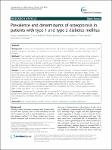Prevalence and determinants of osteoporosis in patients with type 1 and type 2 diabetes mellitus
Leidig-Bruckner, Gudrun
Grobholz, Sonja
Bruckner, Thomas
Scheidt-Nave, Christa
Nawroth, Peter
Schneider, Jochen G.
Background: Increased risk of osteoporosis and its clinical significance in patients with diabetes is controversial. We analyze osteoporosis prevalence and determinants of bone mineral density (BMD) in patients with type 1 and 2 diabetes. Methods: Three hundred and ninety-eight consecutive diabetic patients from a single outpatient clinic received a standardized questionnaire on osteoporosis risk factors, and were evaluated for diabetes-related complications, HbA1c levels, and lumbar spine (LS) and femoral neck (FN) BMD. Of these, 139 (71 men, 68 women) type 1 and 243 (115 men, 128 women) type 2 diabetes patients were included in the study. BMD (T-scores and values adjusted for age, BMI and duration of disease) was compared between patient groups and between patients with type 2 diabetes and population-based controls (255 men, 249 women). Results: For both genders, adjusted BMD was not different between the type 1 and type 2 diabetes groups but was higher in the type 2 group compared with controls (p
No license information

